Chicagoland Grows Releases New Panicum and Vernonias
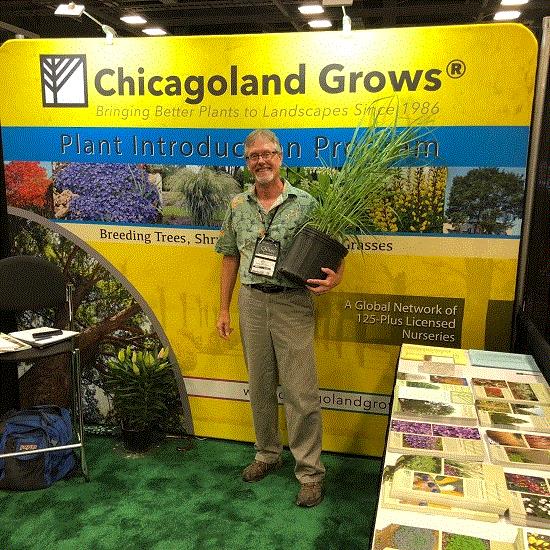
Jim Ault, Chicago Botanic Garden, with Panicum Bad Hair Day, one of the 2019 introductions from Chicagoland Grows, Inc.
During Cultivate’18, I was able to catch up with Jim Ault, plant breeder at the Chicago Botanic Gardens in Glencoe and the person behind the Chicagoland Grows, Inc. plant introduction program by the Chicago Botanic Garden, the Morton Arboretum and Ornamental Growers Association of Northern Illinois (OGA).
Chicagoland Grows is releasing two native selections in 2019: Panicum Bad Hair Day, and Vernonia Summer’s Surrender and Summer’s Swan Song.
Panicum Bad Hair Day is an interspecific cross of the selection Panicum amarum Dewy Blue with named selections of Panicum virgatum. Jim selected Bad Hair Day from the crosses in 2007 and subsequently trialed it in-ground for three years prior to release. Plants are tall—almost 6 ft. by nearly 7.5-ft. wide at maturity. Leaves are weeping. Inflorescence stalks are much denser than other panicums and that, combined with weeping foliage, makes plants look like a mop head—hence the name Bad Hair Day. Jim suspects plants may be more salt tolerant due to P. amarum blood. He’s also noted that plants show good winter persistence, even through Chicagoland snowstorms.
Jim’s vernonia introductions are the result of interspecific hybrids and selected for tolerance to rust and powdery mildew, a problem for the perennial in landscapes in the region. Vernonia Summer’s Surrender resulted from crosses between V. arkansana and V. lettermannii. Summer’s Surrender at maturity is about 4-ft. tall and more than 6- to 7-ft. wide. However, staking isn't required. Plants flower from early September to early October in Chicagoland. Jim reports that he’s noted a wide range of butterflies, moths and bees on the flowers.
Vernonia Summer’s Swan Song is the result of crosses between V. lettermannii and V. angustifolia Plum Peachy. Flowering begins in early September and lasts until about mid-October in Chicagoland. Plants are much more compact than Summer’s Surrender, measuring about 2.5-ft. tall by almost 3-ft. wide at three years. Plants have shown good resistance to rust and powdery mildew. Jim reports that he’s noted a wide range of butterflies, moths and bees on the flowers. Jim adds that you can look for more vernonia introductions in the future.
_________________________________________________________________

The Homogeneous American Dream—Lawns, Biological Deserts?
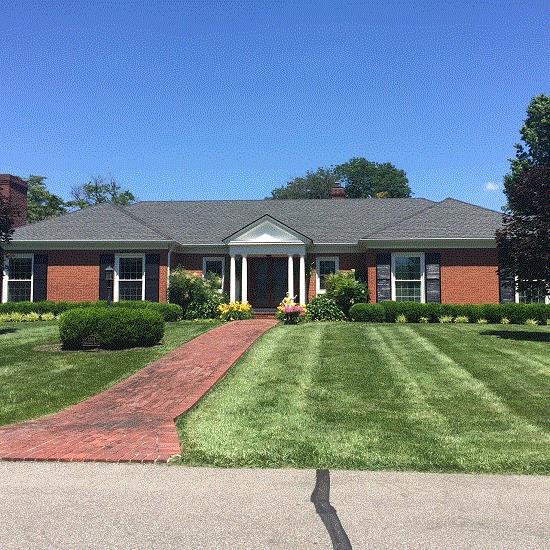
The desire to fit in could be harming biodiversity of the American residential landscape from coast to coast.
The National Science Foundation (NSF) study of residential lawns as part of the Long-Term Ecological Research (LTER) sites shows that biodiversity of suburban ecosystems is in decline. Lawn maintenance contributes to a continental-scale ecological homogenization when long-term study sites bordering Phoenix, Baltimore, Minneapolis-St. Paul, Miami, Boston and Los Angeles are investigated.
“The cities were selected to represent different climates and vegetation types across the U.S., making the similarities in residential lawns even more striking,” says Peter Groffman of the City University of New York and the Cary Institute of Ecosystem Studies.
Turfgrass comprises the majority of residential lawn plants. Although species differed among research sites, they shared similar community compositions. The study also found that sites shared the same weeds, indicating that factors other than human planting practices are contributing to the narrowing of lawn plant biodiversity.
Weeds are often present in turfgrass seeds, and lawn maintenance and disturbed soils create an environment in which these species are successful. On the positive side, says Doug Levey, an NSF LTER program director, "Although many of these plants are non-native, some have flowers that support native pollinators. Dandelions and clover are examples."
Demographic components of the residential areas were incorporated into the study. Researchers found that higher-income households had lawns with significantly less plant diversity than those of lower-income homes. According to the authors, that’s likely due to the fact that high-income households can afford to spend more on lawn care services that remove unwanted plants, ultimately lowering biodiversity.
The study noted that “lawns and nitrogen cycling processes were not different between front and backyards. Yards, however, had more species of vegetation in backyards than front yards.”
New research is exploring what American lawns could look like. Scientists are evaluating whether interest in xeriscaping, improving wildlife habitat and capturing runoff will lead to significant changes.
—Excerpted in good part from an NSF release, Are our lawns biological deserts? by Cheryl Dybas
A multi-city comparison of front and backyard differences in plant species diversity and nitrogen cycling in residential landscapes by Dexter Locke et al in Landscape and Urban Planning.
_________________________________________________________________

Will New York Be the Next City to Mandate Green Roofs?
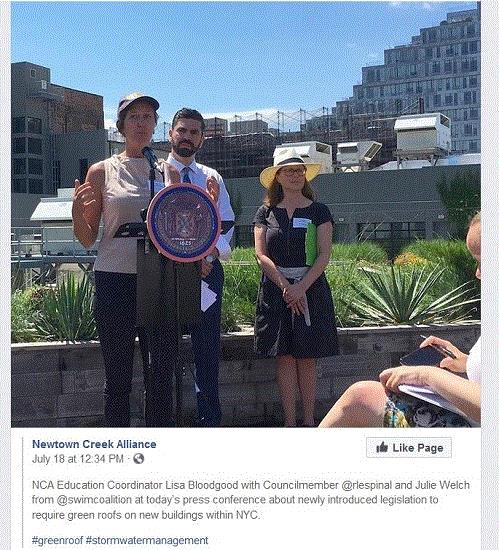
Facebook screen shot from New York City Councilman Rafael Espinal’s feed showing Lisa Bloodgood, Councilmember Espinal and Julie Welch during a press conference in mid-July announcing legislation the Councilman introduced to expand green roofs in New York City.
A group of New York City Councilmen want to green the 1.6 billion sq. ft. of rooftops in the city. New York City Council Member Rafael Espinal held a press conference in mid-July to announce legislation to expand green roofs. He's joined by colleagues City Councilmen Donovan Richards and Steve Levin.
“The time to fight climate change is now,” said Council Member Espinal. “By greening every single rooftop in New York City, we will make a strong commitment to doing our part to protect the planet. In the most famous landscape in the world, New York City could turn our concrete jungle into a green oasis."
"With this legislation, New York City joins a growing family of cities that are using rooftops to manage stormwater, generate clean energy, reduce the urban heat island, provide green jobs and generate much-needed recreational spaces," said Steven W. Peck, Founder and President of Green Roofs for Healthy Cities, the green roof and wall industry association.
—Excerpted in part from Council Members Rafael Espinal, Donovan Richards, Stephen Levin Launch Campaign to Green New York City Roofs, a Green Roofs for Healthy Cities press release
Also see Council Member Espinal Wants Mandatory Green Roofs on New Buildings by Angely Mercado on Bushwick Daily, Council pushes green infrastructure at new developments by Joe Anuta in Crain’s New York and New York City Council introduces legislation to expand green roofs, solar installs in city by Kelly Pickerel on Solar Power World Online.
________________________________________________________________________________________

Breast Cancer Research Gets $1 million+ from Hydrangea arborescens Sales
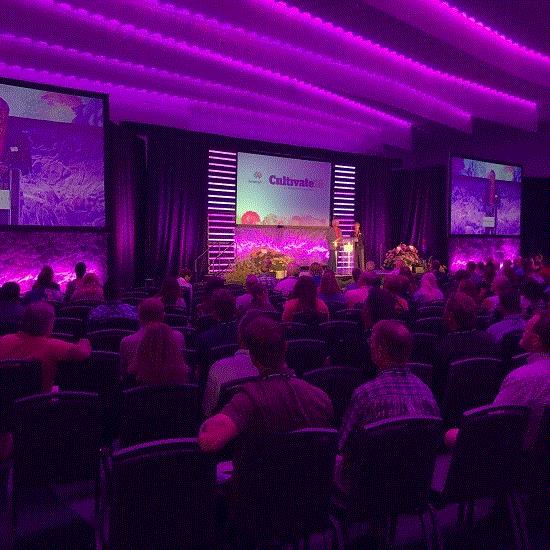
Dale Deppe, Spring Meadow Nursery, announced during the Cultivate’18 show that not only did his team meet their goal of $1 million for breast cancer research from sales of Hydrangea arborescens Invincibelle Spirit, but they’ve exceeded it.
Hydrangea arborescens Invincibelle, bred by Dr. Tom Ranney at NC State University and brought to market by Spring Meadow Nursery, has surpassed their $1 million fundraising goal for breast cancer.

The Hydrangea arborescens Invincibelle Spirit campaign developed by Spring Meadow has donated more than $1 million to The Breast Cancer Research Foundation (BCRF). For every Invincibelle Spirit plant sold, a $1 per plant donation goes to BCRF.
GI Provides City Curb Appeal
Promoting Parks and Recreation’s Role in Economic Development published for the National Recreation and Park Association by George Mason University provides a framework for understanding the role urban greenspace plays in attracting economic development.
Parks help cities provide a sense of place and community. When residents have a high quality of life, companies want to locate there because workers live there, thus jobs get created. That’s especially true of creative and entrepreneurial industries, the report says.
Green infrastructure like parks are especially important when economic developers are hosting prospective clients on site visits. “Communities only have one chance to make a positive first impression.”
The report includes case studies from across the country featuring municipalities across a range of sizes.
____________________________________________________________________
IN Edges Into Ban on Sale of Invasives; PA Takes Aim at Berberis
The Indiana Natural Resources Council (NRC) granted preliminary adoption to a rule designed to remove 44 invasive plants from trade inside Indiana at their July meeting. The decision begins the deliberative rules process for rules adoption in the state. It doesn't put a new rule into effect at this time, according to an Indiana Department of Natural Resources press release.
The proposed rule would ban the sale of 44 invasive plants. Currently, DNR says that 22 of the 44 plants are found in the plant trade, just four of them are sold regularly. The rule would be implemented in stages, allowing the sale of plants for one year to deplete stock before penalties would be implemented.
Currently, invasive species management costs various state agencies in the state of Indiana about $86 million per year. The State of Indiana’s Invasive Plant Species Assessment Work Group (IPSAWG) has developed assessments for a number of plants to help create agreement on which plants are problem plants.
Proposed list of prohibited invasive plants:
-
Achyranthes japonica (Japanese chaff flower)
-
Ailanthus altissima (tree of heaven)
-
Alliaria petiolata (garlic mustard)
-
Alnus glutinosa (black alder)
-
Artemisia vulgaris (mugwort)
-
Arthraxon hispidus (small carpgrass)
-
Berberis thunbergii (Japanese barberry)
-
Carduus acanthoides (spiny plumeless thistle)
-
Carduus nutans (musk thistle)
-
Celastrus orbiculatus (Asian bittersweet)
-
Centaurea stoebe (spotted knapweed)
-
Cirsium vulgare (bull thistle)
-
Conium maculatum (poison hemlock)
-
Convolvulus arvensis (field bindweed)
-
Coronilla varia (crown vetch)
-
Dioscorea polystachya (oppositifolia) (Chinese yam)
-
Dipsacus fullonum (common teasel)
-
Dipsacus laciniatus (cut-leaved teasel)
-
Elaeagnus umbellata (autumn olive)
-
Euonymus fortunei (wintercreeper)
-
Euphorbia esula (leafy spurge)
-
Frangula alnus (glossy buckthorn)
-
Hesperis matronalis (dame’s rocket)
-
Humulus japonicus (Japanese hops)
-
Lepidium latifolium (pepperweed)
-
Lespedeza cuneata (sericea lespedeza)
-
Ligustrum obtusifolium (blunt leaved privet)
-
Lonicera japonica (Japanese honeysuckle)
-
Lonicera maacki (Amur honeysuckle)
-
Lonicera morrowii (Morrow’s honeysuckle)
-
Lonicera tatarica (Tatarian honeysuckle)
-
Lonicera x bella (Bell’s honeysuckle)
-
Microstegium vimineum (Japanese stiltgrass)
-
Morus alba (white mulberry)
-
Phalaris arundinacea (reed canarygrass)
-
Phellodendron amurense (Amur cork tree)
-
Phragmites australis subspecies australis (common reed)
-
Polygonum perfoliatum (mile-a-minute vine)
-
Reynoutria japonica (Japanese knotweed)
-
Reynoutria sachalinensis (giant knotweed)
-
Reynoutria x bohemica (Bohemian knotweed)
-
Rhamnus cathartica (common buckthorn)
-
Vincetoxicum nigrum (black swallow-wort)
-
Vincetoxicum rossicum (pale swallow-wort)
Meanwhile, the state of Pennsylvania is considering adding Berberis thunbergii to its regulated plants list. Late last year, Pennsylvania passed the Controlled Plant and Noxious Weed Act. The new law revamps the old Noxious Weed Act and broadens the power of the Department of Agriculture to regulate plants in Pennsylvania, categorizing regulated plants as either “Controlled” or “Noxious weeds.”
The Controlled Plants and Noxious Weeds Committee, established by the act, discussed Berberis at its first meeting late in July. The group is considering adding Berberis to the regulated list as a noxious weed.
Excerpt from Public Opinion, part of the USA Today Network:
Barberry will not be eradicated through regulation, but proactive laws can mitigate its impacts, according to Nathan Hartshorne, a representative on the Mid-Atlantic Invasive Plant Council.
“By encouraging it, by planting it and selling it, we continue to make the situation worse,” he said. “We certainly want to support our horticultural trade in Pennsylvania, but there are many alternatives. Instead of promoting barberry, which hurts Pennsylvania timber and game, we could sell chokeberry, holly, pepperbush, meadowsweet and so many others.”
__________________________________________________________________
For the Love of Plants: Seed Your Future
Just 61% of the 57,600 jobs in horticulture available annually get filled, resulting in significant workforce gaps, according to Seed Your Future.
While most people can recognize 1,000 or more logos and brands, they know fewer than 10 local plants. None of the middle schoolers in focus groups conducted by Seed Your Future knew the word "horticulture." All of this is in light of the fact that more than a third (35%) of American households grow food at home or participate in a community garden. More than three quarters (76%) of all youth believe climate change can be addressed if action is taken now.
These factoids are part of one of the infographics from Seed Your Future, an industry-wide initiative promoting the love of plants and plant careers. If you haven’t seen it yet, watch the video on Seed Your Future’s home page. It’ll inspire you.
_________________________________________________________________
ASLA Joins Real Estate Industry to Fill Talent Pipeline
Speaking of marketing horticulture and green infrastructure jobs to the next generation, the Association of Landscape Architects announced they're collaborating with 28 real estate industry organizations to promote Careers Building Communities. The collaboration highlights landscape architecture and other diverse career paths within the real estate sector.
The organizations, collectively representing more than 10 million jobs, produced their first joint initiative, a new website Careers Building Communities.
__________________________________________________________________
Washington, D.C. Leads in Most Green Roofs Installed in 2017
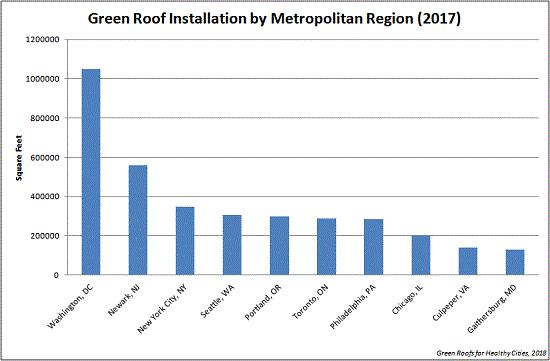
According to the green roof industry trade organization Green Roofs for Healthy Cities (GRHC), Washington D.C. has retaken the top spot for most green roofs installed from Toronto for the greatest square footage of green roof installations in 2017. According to the GRHC Annual Green Roof Industry Survey, Newark, New York City, Seattle, Portland and Toronto followed Washington D.C. in 2017.
"Metropolitan Washington is honored to be recognized by Green Roofs for Healthy Cities as a national leader for installing green roofs," said Tommy Wells, Director of the District of Columbia Department of Energy and Environment. "Our progressive policies and innovative programs, like green roof rebates, Stormwater Retention Credit (SRC) trading and SRC Price Lock, encourage residents and local businesses to install green roofs, which not only make D.C. a beautiful place to live, but also help protect our rivers and streams."
The 2017 Green Roof Industry Survey collected data from 14 of GRHC’s corporate members who collectively recorded more than 1,000 completed projects in 39 U.S. states and five Canadian provinces. These resulted in 5,389,749 sq. ft. of green roofing. The overall industry is likely to be much larger than reported, simply because not all GRHC members participate in the annual survey.
CitiesAlive: 16th Annual Green Infrastructure Conference will be held in Brooklyn, New York, September 24-28, 2018 at the New York Marriot by the Brooklyn Bridge.
—Excerpted from a Green Roofs for Healthy Cities press release
____________________________________________________________________
Can Cities be Proxy Study for Climate Change?
In cities like Raleigh, North Carolina, the effects of urban heat islands on trees and bees are clear, and in some cases, match effects of climate warming in natural areas, says Dr. Steven Frank, NC State University. Higher temperatures mean that trees are more susceptible to pests; Steven’s work with insects on Acer rubrum highlights these results. City bees unaccustomed to high temperatures may leave heat islands to live in cooler city zones or in rural areas—that means some city plants may not be pollinated efficiently.
Steven, a professor in the Department of Entomology and Plant Pathology at NC State, co-authored a paper on the idea that cities can help predict climate change effects.
"Our review synthesized existing studies that used cities as proxies for climate change, particularly higher temperatures,” he said.
"Cities have unique features like buildings and cars that could be confounding variables and need to be accounted for. Likewise, effects on small or immobile organisms like insects and plants may be different from effects on birds, for instance, that could leave a city if it gets too hot," Steven said. “However, we still need to figure out in which instances cities are good proxies for climate change and in which instances they are not.
"Cities could provide a fruitful avenue for climate studies and help predict which species may expand their range or become pests as the climate warms and which species may be in trouble," he continued. "This information will help people involved in conservation and land management plan for the future."
—Excerpted from an NC State University press release Cities as Study Proxies for Climate Change by Mick Kulikowski and Steven Frank
Getting ahead of the curve: cities as surrogates for global change by Eleanor C. Lahr et al, in Proceedings of the Royal Society B: Biological Sciences.
__________________________________________________________________
Native Grass Symposium in September
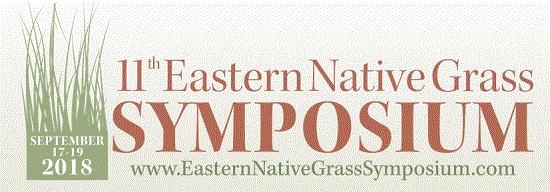
The 11th Eastern Native Grass Symposium will take place September 17-19 at the Bayfront Convention Center in Erie, Pennsylvania. The Symposium will offer 30 sessions led by some of the most dynamic and progressive speakers in their respective professions to share the latest in the use of native grasses and forbs. The theme is “Form & Function: Grasslands and Meadows in the Converging Landscape.”
_____________________________________________________________________
Healing Gardens: Promoting Health & Well Being
Legacy Therapeutic Garden Program presents its 15th therapeutic garden conference, Healing Gardens: Promoting Health and Well Being, on September 15-16 in Portland, Oregon, at the Legacy Emanuel Medical Center Lorenzen Conference Center. Join with conference participants to learn and share strategies to promote interdisciplinary approaches to planning. Target participants include therapists, landscape architects, planners, designers, fundraising teams, horticulturists, garden volunteers, activity professionals, public garden professionals, health and human service providers, parks and recreation teams, students, and philanthropists.
_________________________________________________________________
Worth reading
Best,

Debbie Hamrick
NewTerrain
This email was received by 19,018 readers.
If you're interested in advertising in NewTerrain, contact Kim Brown.